
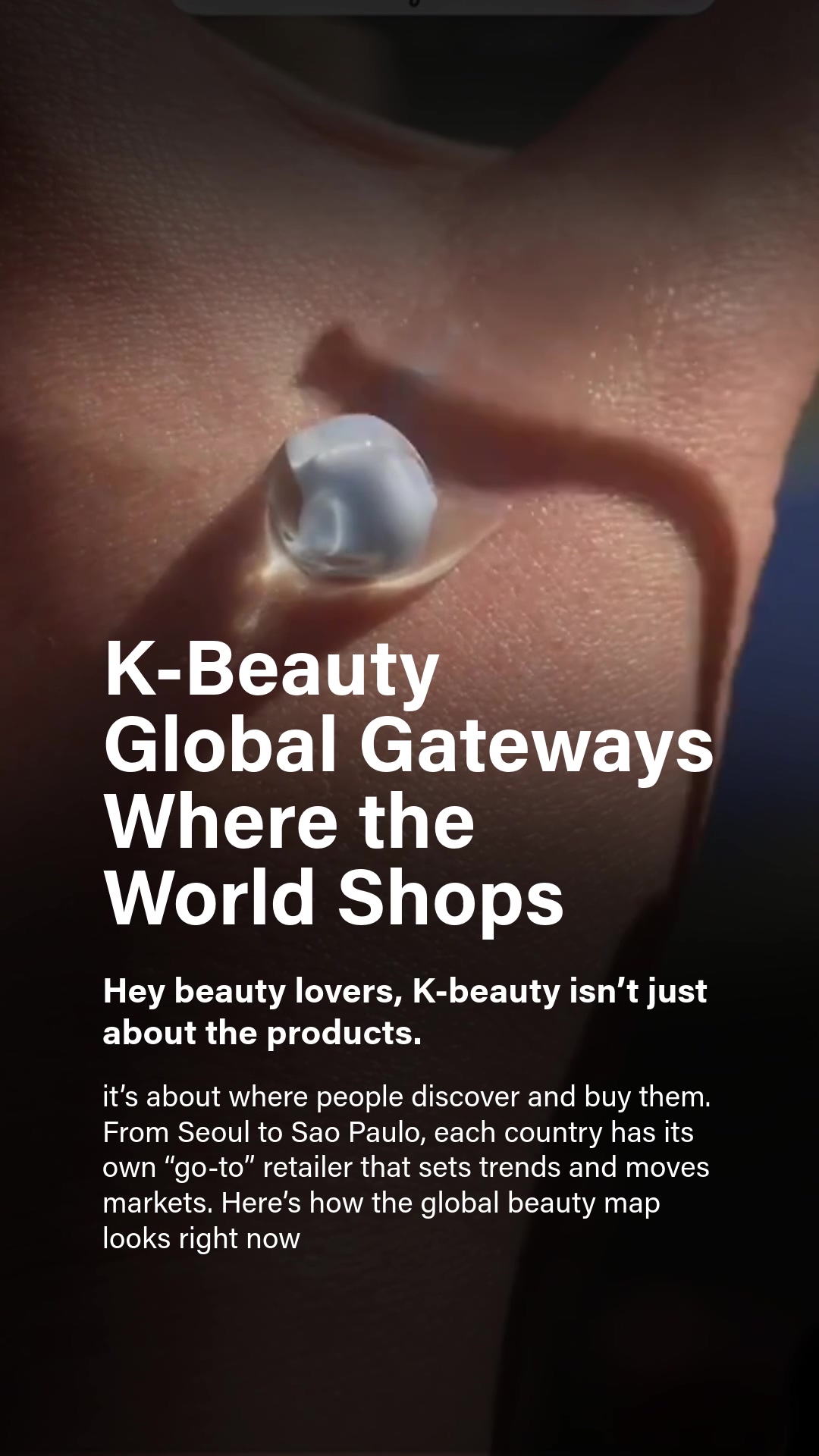
Hey beauty lovers!
K-beauty isn’t just about the formulas or packaging. it’s about where people actually buy it.
From Seoul to São Paulo, every market has its own dominant retailer, both online and offline, that shapes how consumers discover new trends and decide what to trust.
Here’s a closer look at the global map of beauty distribution in 2025.
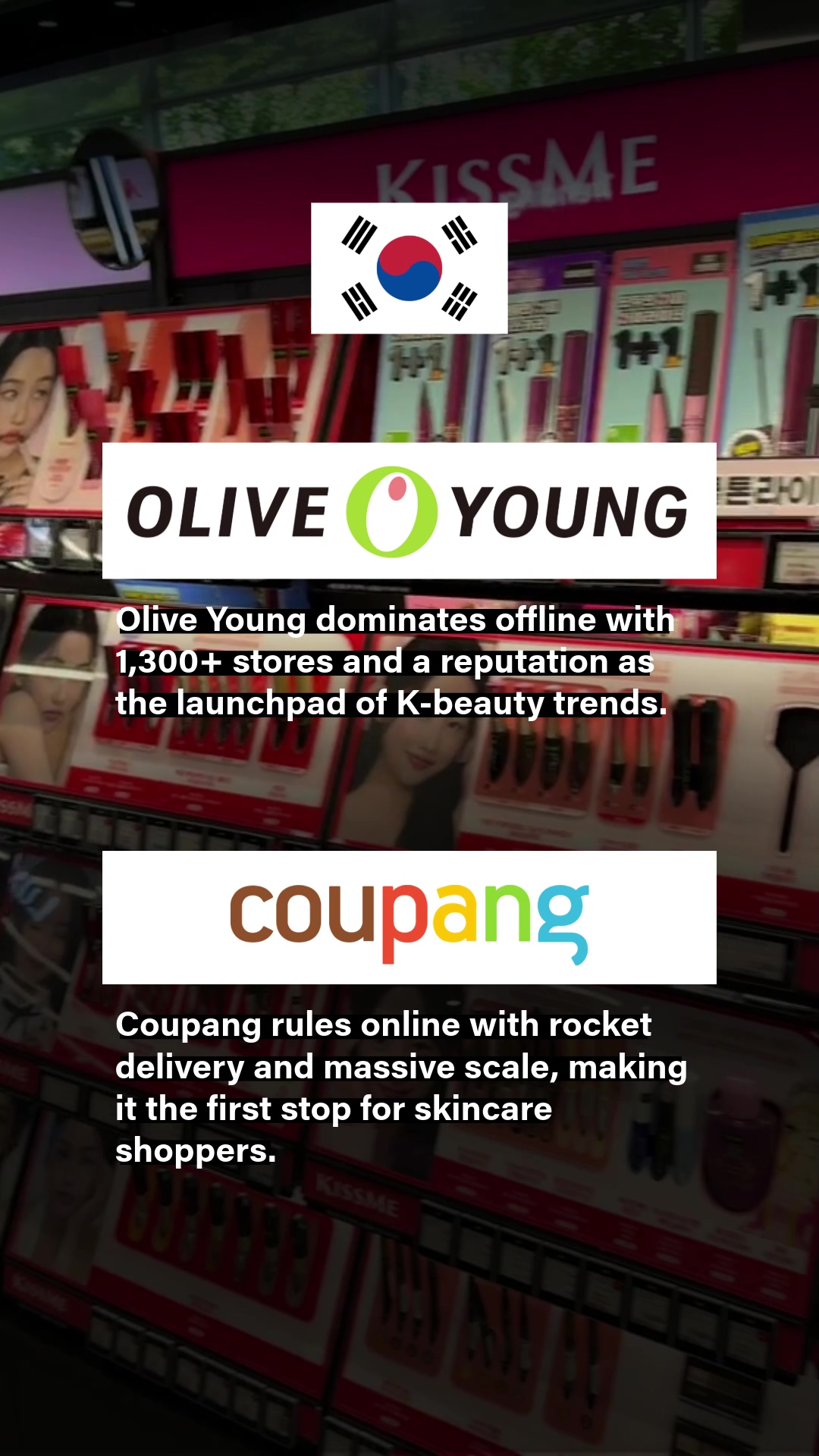
Korea – Olive Young & Coupang
Olive Young (Offline)
With over 1,300 stores nationwide, Olive Young is more than a drugstore it’s the launchpad of K-beauty trends. Foreign tourists visit more than 90% of its locations, making it a must-stop destination. For indie brands, entering Olive Young can mean jumping from obscurity to becoming a household name, as shown by the 100+ brands surpassing ₩10 billion ($7.5M) in annual sales through this channel.
Coupang (Online)
Coupang dominates e-commerce in Korea. In Q1 2025 alone, its sales hit ₩11.5 trillion ($8.5B), growing 21% YoY. With its “rocket delivery” system promising next-day (or even same-day) arrivals, Coupang has become the first place consumers check when buying skincare online.
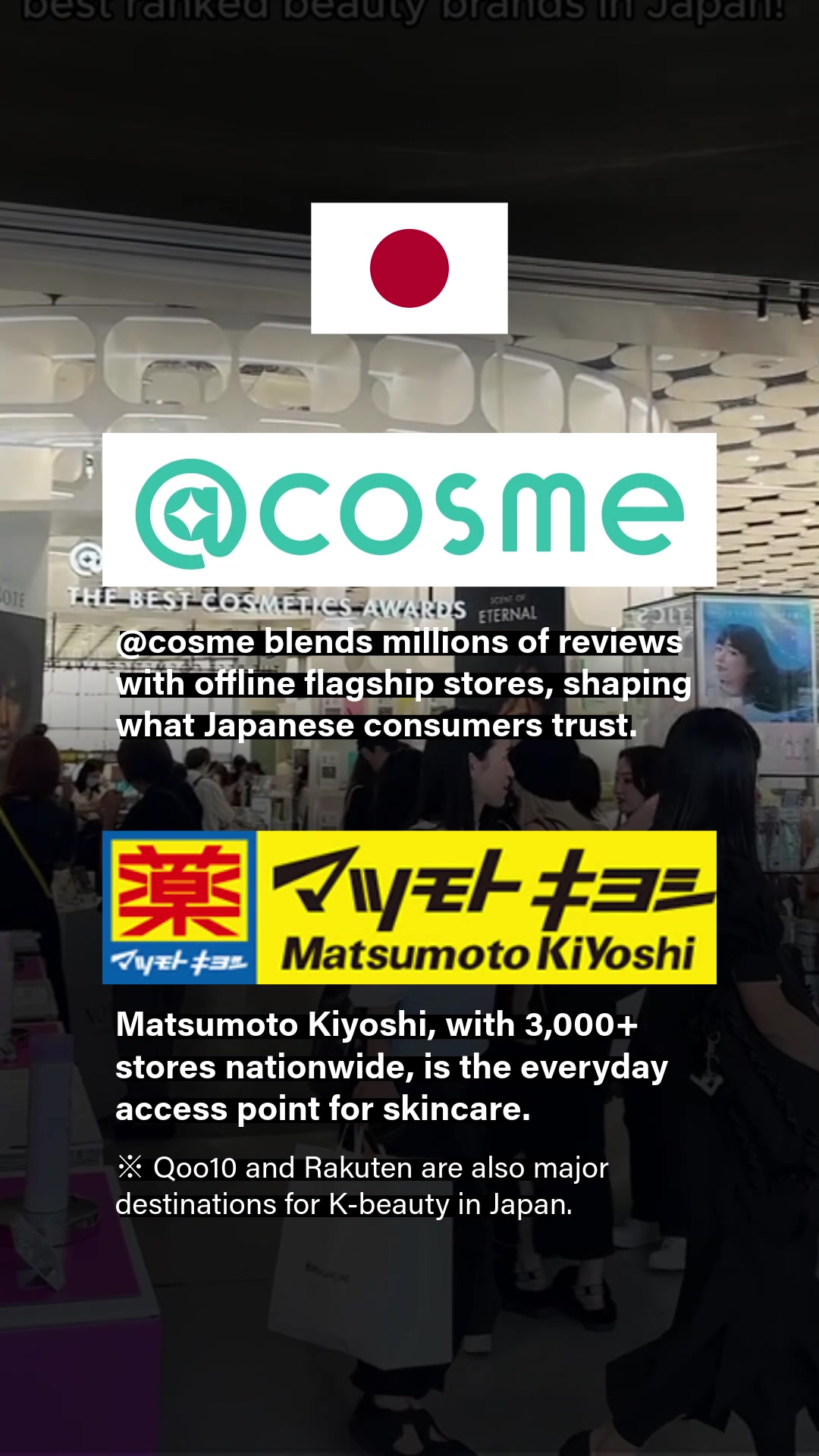
Japan – @cosme & Matsumoto Kiyoshi
@cosme (Online & Flagship Stores)
Japan’s biggest beauty review community, with millions of user reviews, gives @cosme unmatched authority. Its annual Best Cosmetics Awards often send winning products flying off shelves within days. Flagship @cosme Stores in Tokyo and Osaka translate digital trust into real-life shopping.
Matsumoto Kiyoshi (Offline)
With around 3,000 stores, “Matsukiyo” is Japan’s everyday skincare access point. Affordable pricing, convenient locations, and a wide assortment of domestic and imported skincare make it the most accessible touchpoint for the mass market.
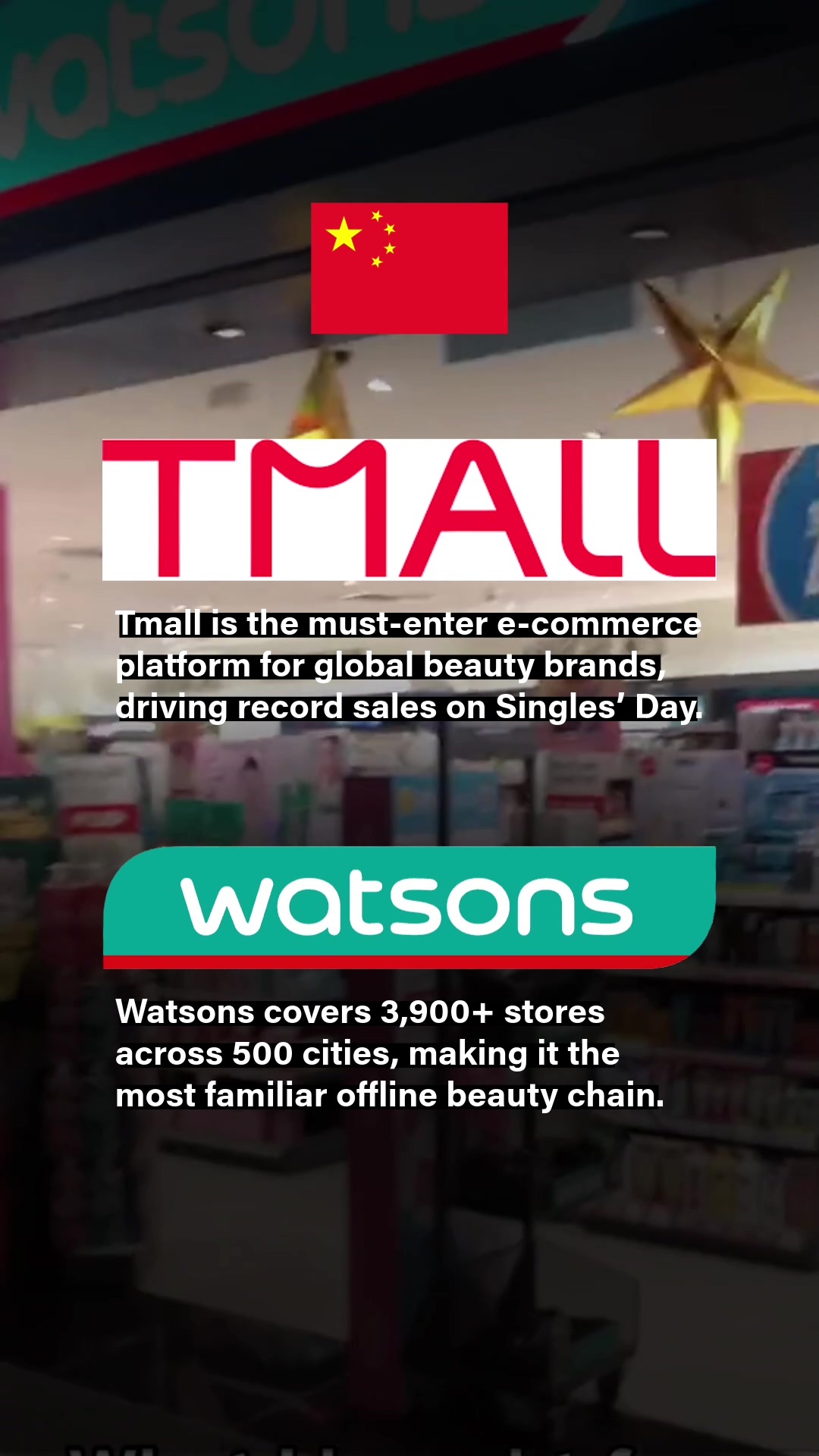
China – Tmall & Watsons
Tmall (Online)
Owned by Alibaba, Tmall is the must-enter marketplace for global beauty brands. During Singles’ Day (11.11) alone, sales often reach tens of billions of dollars, and beauty is consistently a top-performing category. For K-beauty brands, opening a flagship on Tmall is considered a non-negotiable step.
Watsons China (Offline)
Operating 3,900+ stores across 500 cities, Watsons remains the most familiar beauty chain in China. The brand has embraced “O+O” (Offline plus Online) strategies, blending in-store experiences with digital shopping. For K-beauty, Watsons offers exposure to both Tier 1 cities and beyond.
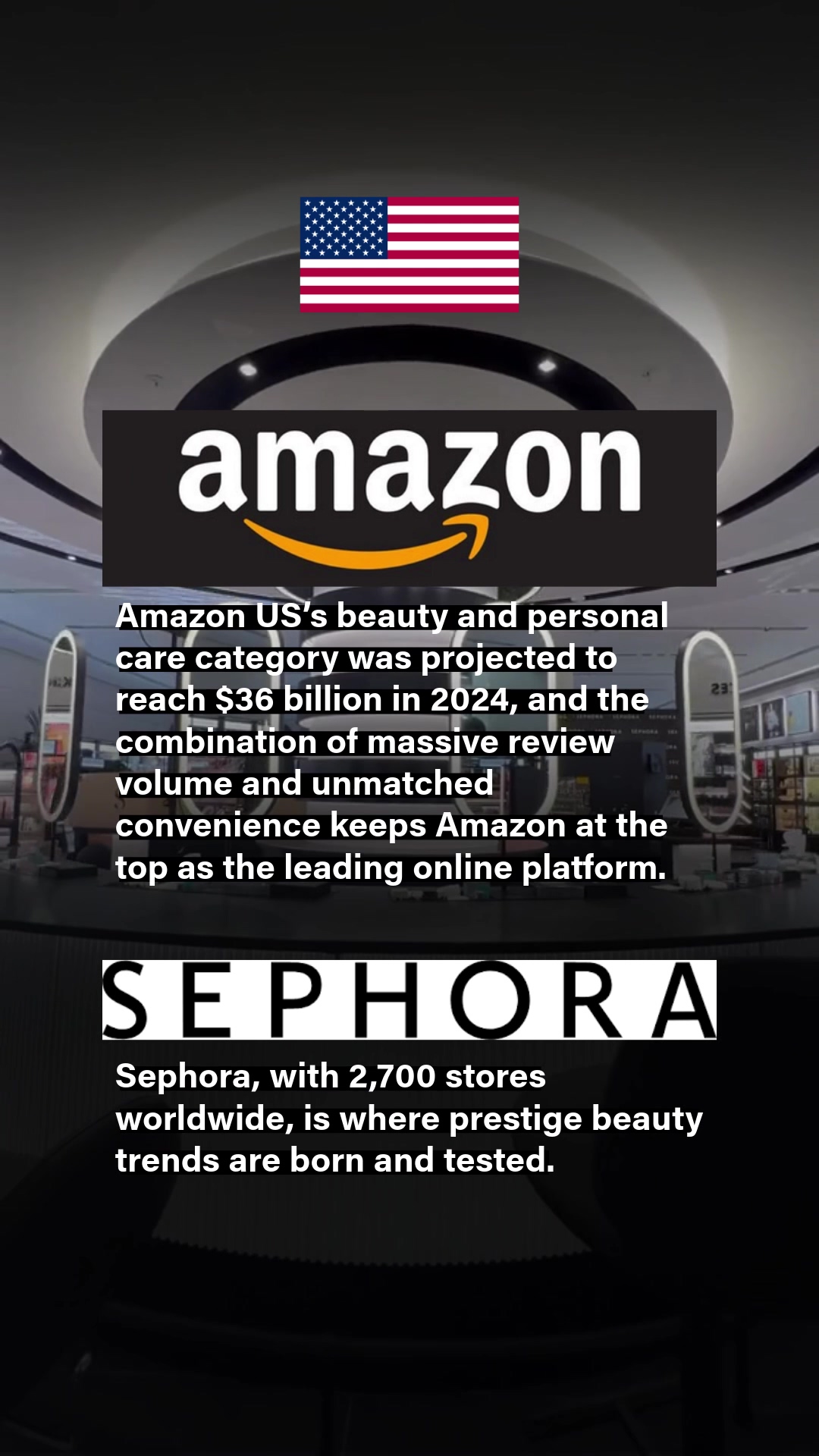
United States – Amazon & Sephora
Amazon (Online)
Amazon’s U.S. beauty and personal care sales were projected to reach $36B in 2024 (+26% YoY). With hundreds of thousands of reviews, product rankings, and unbeatable convenience, Amazon is the default first stop for skincare shoppers. K-beauty brands like Beauty of Joseon and COSRX have become Amazon darlings, often trending during Prime Day.
Sephora (Offline)
With 2,700 stores worldwide, Sephora is where prestige beauty trends are born. It’s not just a retailer — it’s a cultural hub where consumers try, test, and adopt new brands. Sephora’s curated selection of premium and indie brands, and its recent expansion of K-beauty offerings, reinforce its role as the U.S. beauty trendsetter.
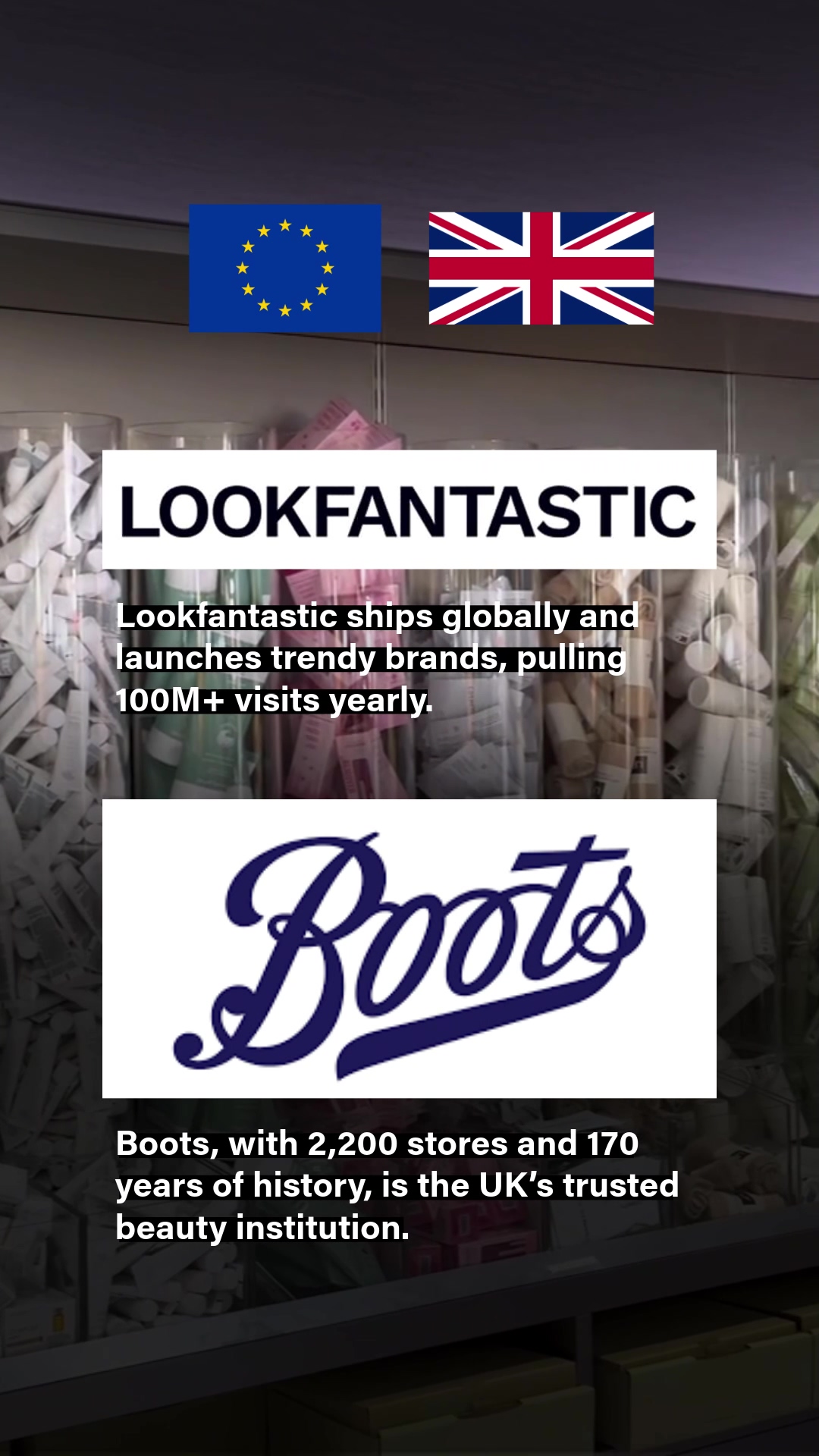
Europe (UK) – Lookfantastic & Boots
Lookfantastic (Online)
Part of The Hut Group, Lookfantastic attracts over 100 million annual visits. It ships globally and is known for introducing niche and trendy brands into the European market. For many K-beauty fans, it’s the easiest way to access products across the EU.
Boots (Offline)
Founded over 170 years ago, Boots runs 2,200+ stores in the UK alone. Known as the “nation’s drugstore,” Boots balances affordable everyday skincare with prestige brand launches, making it a trusted authority in both mass and premium categories.
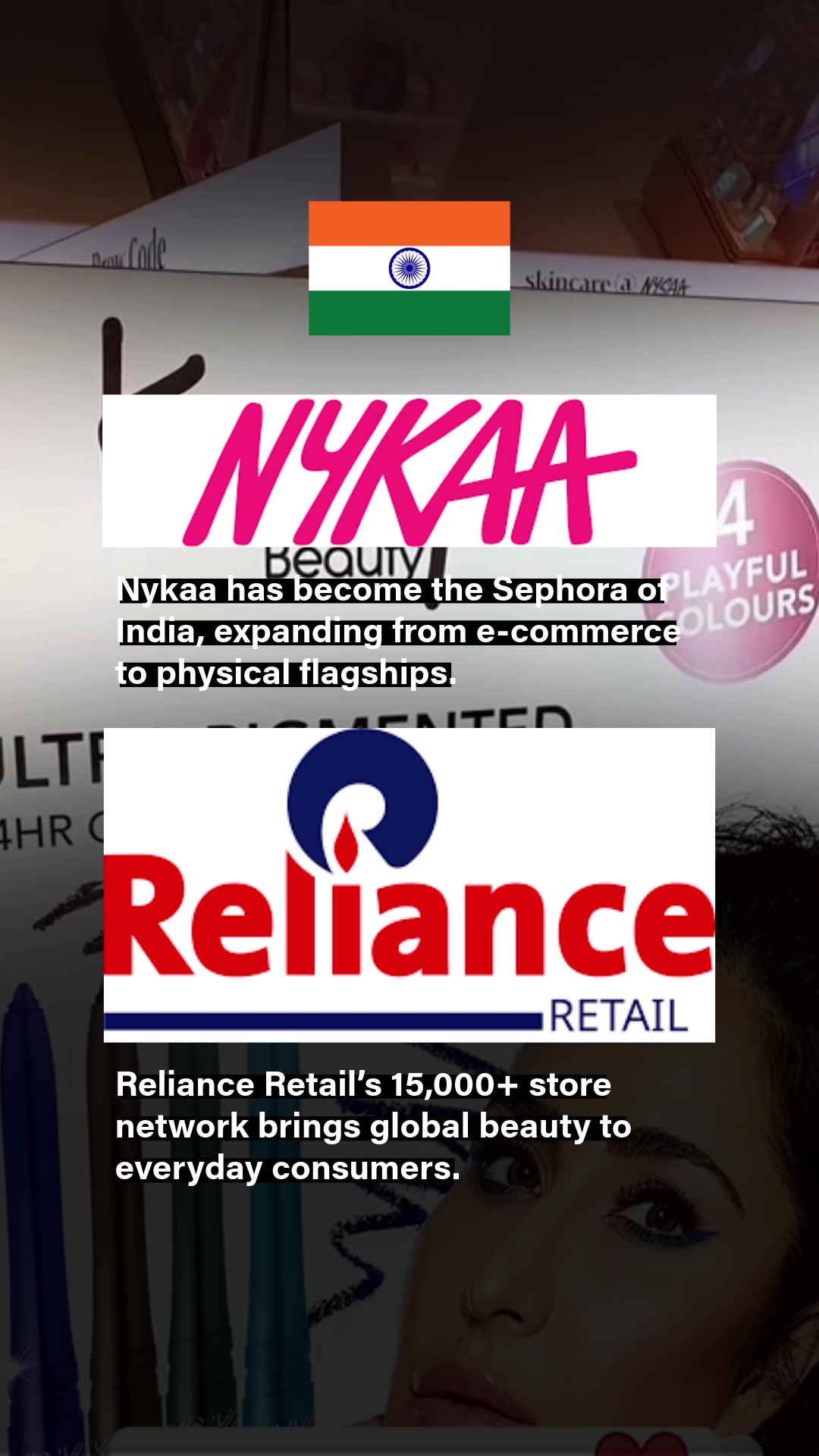
India – Nykaa & Reliance Retail
Nykaa (Online & Offline)
Dubbed the “Sephora of India,” Nykaa started as an e-commerce platform and has since expanded into 150+ physical stores across major Indian cities. Its IPO in 2021 cemented it as a beauty powerhouse, and it continues to lead in premium brand launches and K-beauty expansion.
Reliance Retail (Offline)
Backed by Reliance Industries, this retail giant operates 15,000+ stores across multiple formats. With immense distribution power, Reliance Retail has been instrumental in bringing global beauty brands into India’s mainstream.
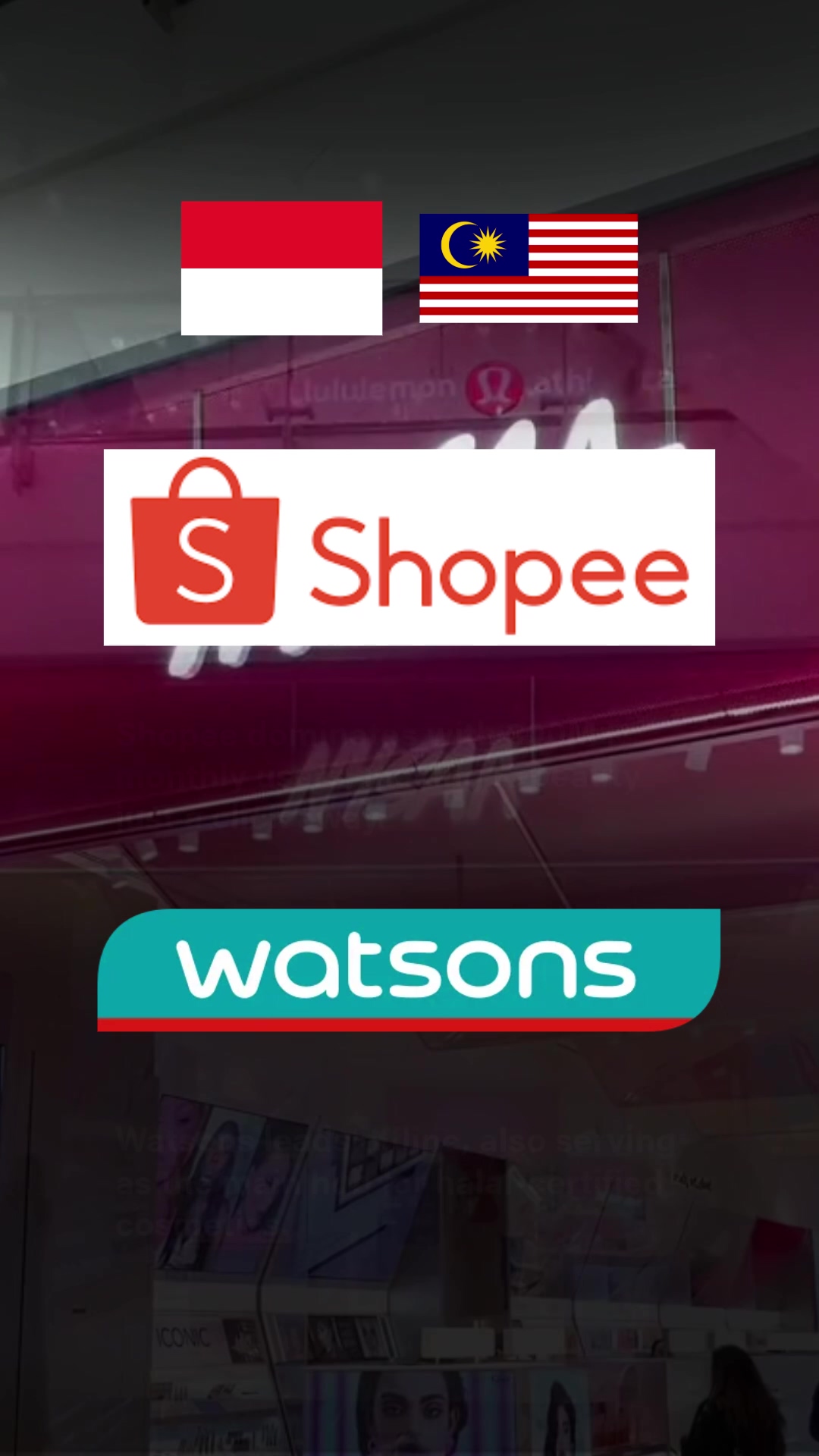
Indonesia / Malaysia – Shopee & Watsons
Shopee (Online)
With 300M+ monthly users across Southeast Asia, Shopee is the digital mall where beauty thrives. K-beauty consistently ranks among its top-selling categories, driven by mobile-first shopping culture.
Watsons (Offline)
In Malaysia alone, Watsons operates 600+ stores, serving as the main hub for halal-certified cosmetics. Its role in curating K-beauty alongside local halal brands has made it the most trusted offline beauty chain.
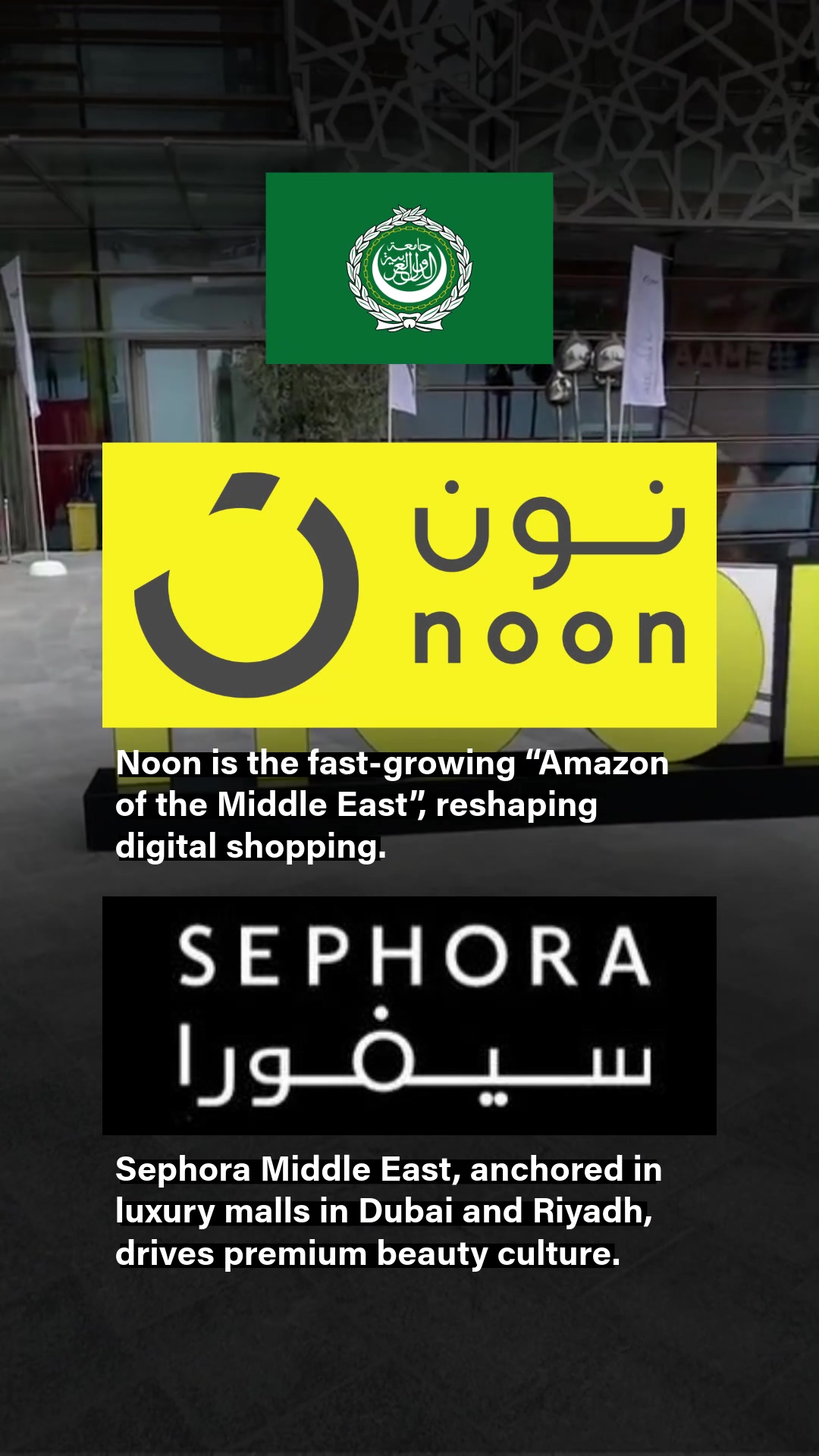
Middle East – Noon & Sephora Middle East
Noon (Online)
Often called the “Amazon of the Middle East,” Noon is a rising force in Saudi Arabia and the UAE. With local payment options and regional logistics, Noon has become the go-to online marketplace for beauty.
Sephora Middle East (Offline)
Anchored in luxury malls in Dubai and Riyadh, Sephora Middle East offers prestige brands and exclusive launches. It defines premium beauty culture in the region and has become a magnet for affluent young consumers.
Brazil / Mexico – Mercado Libre & Sephora
Mercado Libre (Online)
With $14.8B revenue in 2024, Mercado Libre is Latin America’s largest e-commerce platform. Its fast-growing beauty category has become a key channel for international brands.
Sephora (Offline)
Sephora Brazil and Mexico serve as the central stage for global prestige beauty launches, bridging Latin American consumers with global trends.
Australia / New Zealand – Adore Beauty & Mecca
Adore Beauty (Online)
Australia’s largest online beauty retailer, with 4M+ annual visitors, Adore Beauty is known for trusted reviews, speedy delivery, and a wide selection of global brands.
Mecca (Offline)
With 100+ stores across Australia and New Zealand, Mecca is the closest rival to Sephora. Its curated luxury and indie brand mix makes it the go-to destination for premium skincare shoppers.
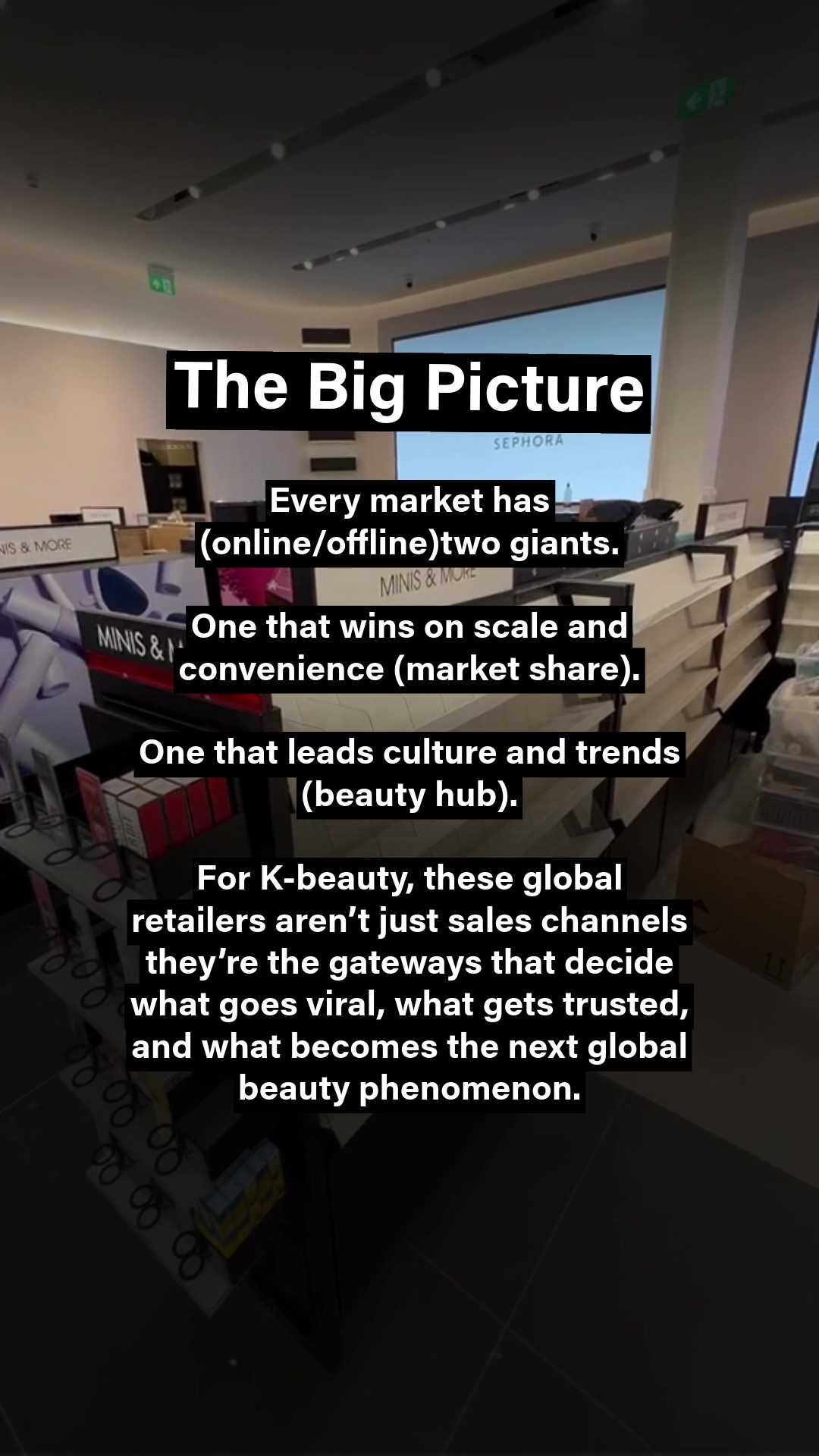
The Big Picture
Across markets, two kinds of giants define the beauty retail landscape.
Market Share Leaders online platforms like Amazon, Tmall, Coupang, Shopee, Mercado Libre.
Trendsetters & Hubs offline curators like Sephora, Olive Young, Boots, Mecca.
For K-beauty, these aren’t just distribution channels. They are the global gateways that determine which products go viral, which brands earn consumer trust, and ultimately, which trends travel across borders.
 102Comments
102Comments-
 여성콤비네이션2 mo. agoOlive Young Global is basically the Sephora of K-beauty now.
여성콤비네이션2 mo. agoOlive Young Global is basically the Sephora of K-beauty now. -
 여성마른2 mo. agoAmazon K-beauty section is growing fast, but fakes are a problem
여성마른2 mo. agoAmazon K-beauty section is growing fast, but fakes are a problem -
 여성예민한2 mo. agoShopee dominating SEA makes sense it’s where everyone shops.
여성예민한2 mo. agoShopee dominating SEA makes sense it’s where everyone shops. -
 여성기름진2 mo. agoU.S. TikTok Shop feels risky though—too many scams.
여성기름진2 mo. agoU.S. TikTok Shop feels risky though—too many scams. -
 여성콤비네이션2 mo. agoWish there were more direct brand-owned stores globally, not just resellers.
여성콤비네이션2 mo. agoWish there were more direct brand-owned stores globally, not just resellers. -
 여성마른2 mo. agoI only buy K-beauty on Amazon now.
여성마른2 mo. agoI only buy K-beauty on Amazon now. 여성예민한2 mo. agoBrave, but I got fakes twice. Never again.
여성예민한2 mo. agoBrave, but I got fakes twice. Never again. 여성예민한2 mo. agoSame, official sites or Olive Young Global are safer.
여성예민한2 mo. agoSame, official sites or Olive Young Global are safer. -
 여성콤비네이션2 mo. agoBoots. REAL
여성콤비네이션2 mo. agoBoots. REAL -
 여성마른2 mo. agoMost people think of Don Quijote, but @cosme and Matsumoto Kiyoshi are the real top two. If you’re in Fukuoka, Tenjin LOFT is huge as well.
여성마른2 mo. agoMost people think of Don Quijote, but @cosme and Matsumoto Kiyoshi are the real top two. If you’re in Fukuoka, Tenjin LOFT is huge as well. 여성정상2 mo. ago@cosme’s awards moving shelves in days is still wild to me
여성정상2 mo. ago@cosme’s awards moving shelves in days is still wild to me 여성정상2 mo. agoI just wish restocks were faster; scalpers ruin it.
여성정상2 mo. agoI just wish restocks were faster; scalpers ruin it. -
 여성정상2 mo. agoRemember when duty free was THE place for K-beauty?
여성정상2 mo. agoRemember when duty free was THE place for K-beauty? -
 여성정상2 mo. agoOlive Young being a tourist must-stop with 1,300+ stores explains why indie brands blow up overnight
여성정상2 mo. agoOlive Young being a tourist must-stop with 1,300+ stores explains why indie brands blow up overnight -
 여성콤비네이션2 mo. agoCoupang’s rocket delivery makes online skincare basically instant dangerous for my wallet.
여성콤비네이션2 mo. agoCoupang’s rocket delivery makes online skincare basically instant dangerous for my wallet. -
 여성마른2 mo. agoAmazon’s review engine makes K-beauty discoverable, but Sephora still defines prestige narratives.
여성마른2 mo. agoAmazon’s review engine makes K-beauty discoverable, but Sephora still defines prestige narratives. -
 여성기름진2 mo. agoLookfantastic is clutch for EU access; Boots bridges mass to premium on the high street.
여성기름진2 mo. agoLookfantastic is clutch for EU access; Boots bridges mass to premium on the high street. -
 여성마른2 mo. agoShopee deals are unbeatable; who pays mall prices anymore?
여성마른2 mo. agoShopee deals are unbeatable; who pays mall prices anymore? 여성예민한2 mo. agoWatsons’ curation + returns policy are worth the premium skin > savings
여성예민한2 mo. agoWatsons’ curation + returns policy are worth the premium skin > savings 여성정상2 mo. ago@여성/예민한 Enjoy overpaying then. I’ll keep stacking vouchers
여성정상2 mo. ago@여성/예민한 Enjoy overpaying then. I’ll keep stacking vouchers -
 FemaleNormal2 mo. agoAmazon is the default here, reviews and fast shipping win casual shoppers.
FemaleNormal2 mo. agoAmazon is the default here, reviews and fast shipping win casual shoppers. -
 FemaleDry2 mo. agoSephora is where I test shades, discovery happens in person, not only online.
FemaleDry2 mo. agoSephora is where I test shades, discovery happens in person, not only online. -
 FemaleNormal2 mo. agoOlive young is a launchpad, tourists learn trends there and export them home.
FemaleNormal2 mo. agoOlive young is a launchpad, tourists learn trends there and export them home. -
 FemaleNormal2 mo. ago@cosme awards move shelves in days, trust flows from community first.
FemaleNormal2 mo. ago@cosme awards move shelves in days, trust flows from community first. -
 FemaleCombination2 mo. agoMatsukiyo makes everyday access easy, price and proximity beat hype.
FemaleCombination2 mo. agoMatsukiyo makes everyday access easy, price and proximity beat hype. -
 FemaleNormal2 mo. agoTmall is non negotiable for scale, Singles Day rewrites forecasts.
FemaleNormal2 mo. agoTmall is non negotiable for scale, Singles Day rewrites forecasts. -
 FemaleCombination2 mo. agoWatsons China still matters, O plus O journeys convert beyond tier one.
FemaleCombination2 mo. agoWatsons China still matters, O plus O journeys convert beyond tier one. -
 FemaleOily2 mo. agoCoupang rocket delivery spoils you, next day becomes the baseline quickly.
FemaleOily2 mo. agoCoupang rocket delivery spoils you, next day becomes the baseline quickly. -
 FemaleNormal2 mo. agoLookfantastic brings niche names to Europe, cross border shipping is the hook.
FemaleNormal2 mo. agoLookfantastic brings niche names to Europe, cross border shipping is the hook. -
 FemaleSensitive2 mo. agoBoots balances mass and prestige, testers make or break shade picks.
FemaleSensitive2 mo. agoBoots balances mass and prestige, testers make or break shade picks. -
 FemaleNormal2 mo. agoNykaa built a bridge from app to stores, premium launches feel coordinated.
FemaleNormal2 mo. agoNykaa built a bridge from app to stores, premium launches feel coordinated. -
 FemaleDry2 mo. agoReliance Retail gives muscle, distribution turns small brands visible.
FemaleDry2 mo. agoReliance Retail gives muscle, distribution turns small brands visible. -
 FemaleCombination2 mo. agoShopee is the mall on your phone, beauty rides mobile first habits.
FemaleCombination2 mo. agoShopee is the mall on your phone, beauty rides mobile first habits. -
 FemaleNormal2 mo. agoWatsons Malaysia curates halal and k beauty, trust grows at the counter.
FemaleNormal2 mo. agoWatsons Malaysia curates halal and k beauty, trust grows at the counter. -
 FemaleOily2 mo. agoNoon wins with local payments, COD and quick delivery close the sale.
FemaleOily2 mo. agoNoon wins with local payments, COD and quick delivery close the sale. -
 FemaleNormal2 mo. agoSephora Middle East is a scene, launches feel like events not chores.
FemaleNormal2 mo. agoSephora Middle East is a scene, launches feel like events not chores. -
 FemaleNormal2 mo. agoMercado Libre pushes speed, reviews are the make or break for newbies.
FemaleNormal2 mo. agoMercado Libre pushes speed, reviews are the make or break for newbies. -
 FemaleNormal2 mo. agoSephora Mexico bridges global trends, shade ranges must go deeper.
FemaleNormal2 mo. agoSephora Mexico bridges global trends, shade ranges must go deeper. -
 FemaleSensitive2 mo. agoAdore Beauty is review heavy, easy returns keep the cart alive.
FemaleSensitive2 mo. agoAdore Beauty is review heavy, easy returns keep the cart alive. -
 FemaleNormal2 mo. agoMecca is our playground, indie and luxury mix keeps visits frequent.
FemaleNormal2 mo. agoMecca is our playground, indie and luxury mix keeps visits frequent. -
 MaleNormal1 mo. agoAmazon is the default here, reviews plus next day shipping win casual shoppers fast.
MaleNormal1 mo. agoAmazon is the default here, reviews plus next day shipping win casual shoppers fast. -
 MaleNormal1 mo. agoAmazon is the default here, reviews plus next day shipping win casual shoppers fast.
MaleNormal1 mo. agoAmazon is the default here, reviews plus next day shipping win casual shoppers fast. -
 FemaleNormal1 mo. agoSephora Middle East feels like a scene, launches turn into real events not chores.
FemaleNormal1 mo. agoSephora Middle East feels like a scene, launches turn into real events not chores. -
 MaleNormal1 mo. agoTmall is nonnegotiable for scale, Singles Day rewrites forecasts every year.
MaleNormal1 mo. agoTmall is nonnegotiable for scale, Singles Day rewrites forecasts every year. -
 FemaleNormal1 mo. agoOlive Young feels like a tourist launchpad, trends travel home after that.
FemaleNormal1 mo. agoOlive Young feels like a tourist launchpad, trends travel home after that. -
 FemaleDry1 mo. agoSephora is where I test shades, most discovery happens in person for me.
FemaleDry1 mo. agoSephora is where I test shades, most discovery happens in person for me. -
 FemaleCombination1 mo. agoMatsumoto Kiyoshi makes access easy, price and proximity beat hype in daily life.
FemaleCombination1 mo. agoMatsumoto Kiyoshi makes access easy, price and proximity beat hype in daily life. -
 FemaleCombination1 mo. agoShopee is the mall on my phone, beauty rides mobile first habits every day.
FemaleCombination1 mo. agoShopee is the mall on my phone, beauty rides mobile first habits every day. -
 MaleSensitive1 mo. agoBoots style chains teach routines, testers make or break shade picks on the spot, no cap.
MaleSensitive1 mo. agoBoots style chains teach routines, testers make or break shade picks on the spot, no cap. -
 MaleOily1 mo. agoNoon wins with local payments, COD and quick delivery close the sale fast.
MaleOily1 mo. agoNoon wins with local payments, COD and quick delivery close the sale fast. -
 MaleDry1 mo. agoReliance Retail brings muscle, distribution makes small brands suddenly visible.
MaleDry1 mo. agoReliance Retail brings muscle, distribution makes small brands suddenly visible. -
 FemaleNormal1 mo. agoNykaa bridges app and stores well, premium launches feel coordinated and clear.
FemaleNormal1 mo. agoNykaa bridges app and stores well, premium launches feel coordinated and clear. -
 MaleOily1 mo. agoCoupang rocket delivery spoils you, next day quickly becomes the baseline there, for real.
MaleOily1 mo. agoCoupang rocket delivery spoils you, next day quickly becomes the baseline there, for real. -
 FemaleNormal1 mo. agoLookfantastic brings niche names to Europe, cross border shipping is the hook.
FemaleNormal1 mo. agoLookfantastic brings niche names to Europe, cross border shipping is the hook. -
 FemaleSensitive1 mo. agoAdore Beauty is review heavy, easy returns keep carts alive when shades miss.
FemaleSensitive1 mo. agoAdore Beauty is review heavy, easy returns keep carts alive when shades miss. -
 FemaleCombination1 mo. agoPayment prefs (BNPL vs COD) would help targeting a ton.
FemaleCombination1 mo. agoPayment prefs (BNPL vs COD) would help targeting a ton. -
 FemaleCombination1 mo. agoWatsons in China still matters, O plus O flows convert far beyond tier one cities.
FemaleCombination1 mo. agoWatsons in China still matters, O plus O flows convert far beyond tier one cities. -
 FemaleSensitive1 mo. agoCart‑abandon reasons per region would level up strategy.
FemaleSensitive1 mo. agoCart‑abandon reasons per region would level up strategy. -
 MaleNormal1 mo. agoWatsons Malaysia curates halal friendly lines. Labels in big font make shopping easier.
MaleNormal1 mo. agoWatsons Malaysia curates halal friendly lines. Labels in big font make shopping easier. -
 FemaleNormal1 mo. agoSephora Brazil had strong K beauty endcaps last month. Nice to see testers cleaned often.
FemaleNormal1 mo. agoSephora Brazil had strong K beauty endcaps last month. Nice to see testers cleaned often. -
 FemaleOily1 mo. agoSephora Middle East visuals are luxe. I still ask for wear tests to see if formulas suit heat.
FemaleOily1 mo. agoSephora Middle East visuals are luxe. I still ask for wear tests to see if formulas suit heat. -
 FemaleDry1 mo. agoStrong split.
FemaleDry1 mo. agoStrong split. -
 FemaleNormal1 mo. agoReliance Retail distribution looks massive. Consistent pricing across cities would be great.
FemaleNormal1 mo. agoReliance Retail distribution looks massive. Consistent pricing across cities would be great. -
 FemaleNormal1 mo. agoMarketplace vs DTC split was super helpful payment prefs by region next?
FemaleNormal1 mo. agoMarketplace vs DTC split was super helpful payment prefs by region next? -
 FemaleCombination1 mo. agoCross‑border shipping tips would be great.
FemaleCombination1 mo. agoCross‑border shipping tips would be great. -
 MaleNormal1 mo. ago@cosme awards can move shelves in days, community trust powers it.
MaleNormal1 mo. ago@cosme awards can move shelves in days, community trust powers it. -
 FemaleDry1 mo. agoReturn‑rate differences by channel? curious.
FemaleDry1 mo. agoReturn‑rate differences by channel? curious. -
 FemaleNormal1 mo. agoPayment prefs (BNPL/COD) vary so much add a table?
FemaleNormal1 mo. agoPayment prefs (BNPL/COD) vary so much add a table? -
 FemaleNormal1 mo. agoMatsumoto Kiyoshi has solid drugstore finds. I bring a list and focus on refills and cotton.
FemaleNormal1 mo. agoMatsumoto Kiyoshi has solid drugstore finds. I bring a list and focus on refills and cotton. -
 FemaleNormal1 mo. agoTourists crowd the hot stores. Early hours give space to test calmly without pressure.
FemaleNormal1 mo. agoTourists crowd the hot stores. Early hours give space to test calmly without pressure. -
 MaleNormal1 mo. agoTmall flagships help verify listings. I still read date codes and skip too good to be true prices.
MaleNormal1 mo. agoTmall flagships help verify listings. I still read date codes and skip too good to be true prices. -
 FemaleSensitive1 mo. ago@cosme awards move inventory fast. I check winners, then compare ingredients before buying.
FemaleSensitive1 mo. ago@cosme awards move inventory fast. I check winners, then compare ingredients before buying. -
 FemaleOily1 mo. agoPayment prefs (BNPL/COD) vary a lot worth a matrix view.
FemaleOily1 mo. agoPayment prefs (BNPL/COD) vary a lot worth a matrix view. -
 FemaleNormal1 mo. agoBoots mixes everyday with prestige. I like the simple layout and clear offers at checkout.
FemaleNormal1 mo. agoBoots mixes everyday with prestige. I like the simple layout and clear offers at checkout. -
 FemaleDry1 mo. agoMarketplace vs DTC split big brain energy 🧠
FemaleDry1 mo. agoMarketplace vs DTC split big brain energy 🧠 -
 FemaleSensitive1 mo. agoCross‑border shipping tips would be an awesome add‑on.
FemaleSensitive1 mo. agoCross‑border shipping tips would be an awesome add‑on. -
 FemaleNormal1 mo. agoTop cart‑abandon reasons???
FemaleNormal1 mo. agoTop cart‑abandon reasons??? -
 FemaleCombination1 mo. agoCart‑abandon reasons by region next?
FemaleCombination1 mo. agoCart‑abandon reasons by region next? -
 FemaleSensitive1 mo. agoNoon adds local payments that help. Search filters for SPF and fragrance free would be useful.
FemaleSensitive1 mo. agoNoon adds local payments that help. Search filters for SPF and fragrance free would be useful. -
 FemaleNormal1 mo. agoShopee feels like a mall on my phone. I always use official stores and check badges.
FemaleNormal1 mo. agoShopee feels like a mall on my phone. I always use official stores and check badges. -
 FemaleCombination1 mo. agoCross‑border shipping tips would help newbies.
FemaleCombination1 mo. agoCross‑border shipping tips would help newbies. -
 FemaleNormal1 mo. agoMarketplace vs DTC breakdown was super insightful.
FemaleNormal1 mo. agoMarketplace vs DTC breakdown was super insightful. -
 FemaleCombination1 mo. agoMarketplace vs DTC breakdown was super helpful.
FemaleCombination1 mo. agoMarketplace vs DTC breakdown was super helpful. -
 MaleNormal1 mo. agoI want more refill stations and recycling bins near checkout. That would close the loop nicely.
MaleNormal1 mo. agoI want more refill stations and recycling bins near checkout. That would close the loop nicely. -
 FemaleCombination1 mo. agoThese gateways show how discovery changes by region. I pick by returns policy and sample policy first.
FemaleCombination1 mo. agoThese gateways show how discovery changes by region. I pick by returns policy and sample policy first. -
 FemaleSensitive1 mo. agoCart‑abandon reasons by region next?
FemaleSensitive1 mo. agoCart‑abandon reasons by region next? -
 FemaleOily1 mo. agoMarketplace vs DTC breakdown = useful.
FemaleOily1 mo. agoMarketplace vs DTC breakdown = useful. -
 FemaleNormal1 mo. agoWatsons China looks huge online and offline. O plus O makes discovery easy for visitors.
FemaleNormal1 mo. agoWatsons China looks huge online and offline. O plus O makes discovery easy for visitors. -
 FemaleCombination1 mo. agoAmazon is my first stop for reviews. I filter by recent and skin type to find useful notes.
FemaleCombination1 mo. agoAmazon is my first stop for reviews. I filter by recent and skin type to find useful notes. -
 FemaleOily1 mo. agoPayment prefs (BNPL/COD) vary tons table pls.
FemaleOily1 mo. agoPayment prefs (BNPL/COD) vary tons table pls. -
 MaleNormal1 mo. agoNykaa built trust with swatches and returns. That combo matters when trying a new brand.
MaleNormal1 mo. agoNykaa built trust with swatches and returns. That combo matters when trying a new brand. -
 FemaleNormal1 mo. agoOlive Young is like a playground. I map my route by aisle, then hit the sample pads last.
FemaleNormal1 mo. agoOlive Young is like a playground. I map my route by aisle, then hit the sample pads last. -
 FemaleSensitive1 mo. agoCross‑border shipping tips would be clutch for newbies.
FemaleSensitive1 mo. agoCross‑border shipping tips would be clutch for newbies. -
 FemaleCombination1 mo. agoAdd payment prefs (BNPL/COD) per region plsss
FemaleCombination1 mo. agoAdd payment prefs (BNPL/COD) per region plsss -
 MaleNormal1 mo. agoMercado Libre has reach. Verified seller tags and secure shipping protect the order, good step.
MaleNormal1 mo. agoMercado Libre has reach. Verified seller tags and secure shipping protect the order, good step. -
 FemaleNormal1 mo. agoAdore Beauty writes thorough product pages. I read routines and copy the order on busy mornings.
FemaleNormal1 mo. agoAdore Beauty writes thorough product pages. I read routines and copy the order on busy mornings. -
 FemaleDry1 mo. agoSephora is for shade matching and samples. I take photos by the door in daylight and decide later.
FemaleDry1 mo. agoSephora is for shade matching and samples. I take photos by the door in daylight and decide later. -
 MaleNormal1 mo. agoCoupang delivery speed is wild. I wish we had true next day like that in my city.
MaleNormal1 mo. agoCoupang delivery speed is wild. I wish we had true next day like that in my city. -
 MaleNormal1 mo. agoLookfantastic ships quick to me. I set restock alerts so I do not overpay elsewhere.
MaleNormal1 mo. agoLookfantastic ships quick to me. I set restock alerts so I do not overpay elsewhere. -
 FemaleSensitive1 mo. agoCart‑abandon reasons by region, next please.
FemaleSensitive1 mo. agoCart‑abandon reasons by region, next please. -
 FemaleNormal1 mo. agoCurious about return rates across channels.
FemaleNormal1 mo. agoCurious about return rates across channels. -
 MaleNormal1 mo. agoMecca staff explain undertones clearly. I appreciate shade cards I can take outside.
MaleNormal1 mo. agoMecca staff explain undertones clearly. I appreciate shade cards I can take outside.